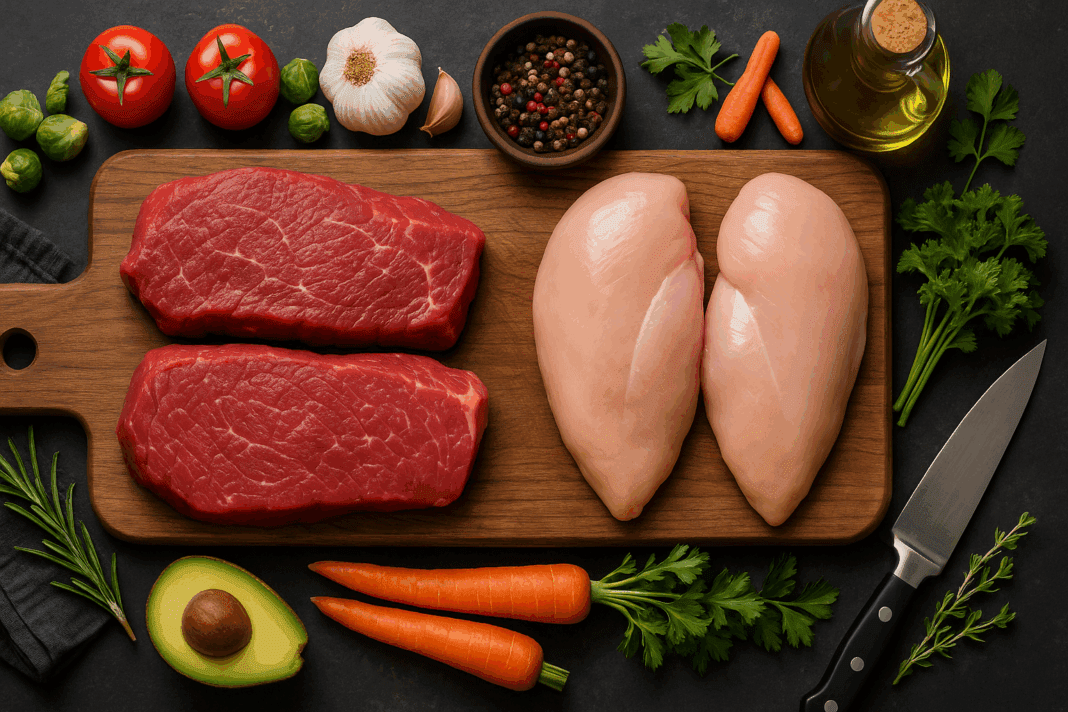When it comes to building muscle, boosting metabolism, or simply maintaining a healthier lifestyle, many individuals turn to high-protein diets. Among the most commonly consumed animal-based proteins are beef and chicken, each with its own unique nutritional profile, benefits, and potential drawbacks. The debate over which is superior has led to a growing interest in understanding the differences between beef vs chicken protein. This article delves deeply into the science, nutritional facts, practical implications, and long-term health impacts of both protein sources, offering a comprehensive guide for anyone seeking to optimize their protein intake with evidence-based insight.
You may also like : The Ultimate Guide to Choosing a High Protein Diet Name That Fits Your Goals
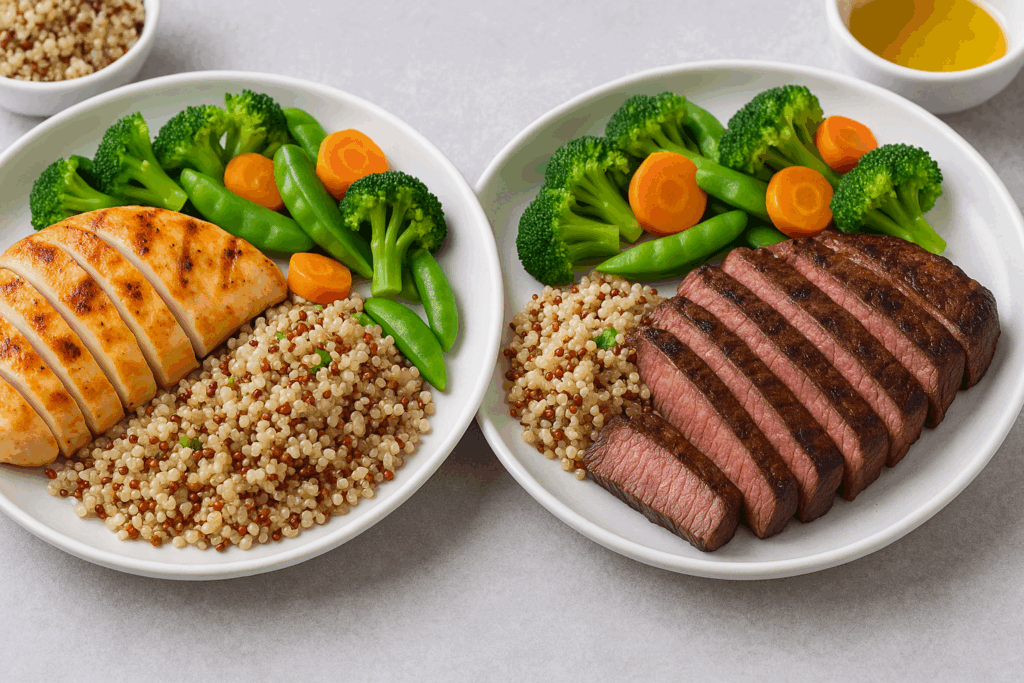
Nutritional Breakdown: Understanding the Macros and Micros
To understand the nutritional advantages of beef vs chicken protein, it’s essential to compare the macro and micronutrient content of each. Chicken breast, often heralded as the leaner choice, is a staple in many high-protein diets due to its low fat and high protein content. A 3.5-ounce serving of skinless, cooked chicken breast contains approximately 165 calories, 31 grams of protein, and 3.6 grams of fat. This makes it ideal for those focused on lean muscle gain without excess calories.
In contrast, a similar portion of cooked lean ground beef (90% lean) contains around 250 calories, 26 grams of protein, and 17 grams of fat. While beef provides slightly less protein per calorie compared to chicken, it offers a richer profile of certain micronutrients. For instance, beef is an excellent source of iron, zinc, and vitamin B12—nutrients crucial for oxygen transport, immune function, and neurological health. These nutrients are present in chicken as well but often in smaller quantities.
Both proteins are complete sources, meaning they contain all nine essential amino acids necessary for muscle repair and overall health. However, beef tends to have higher concentrations of creatine and carnosine, compounds known to enhance athletic performance and recovery. These variations may influence an individual’s choice based on specific health goals or dietary preferences.
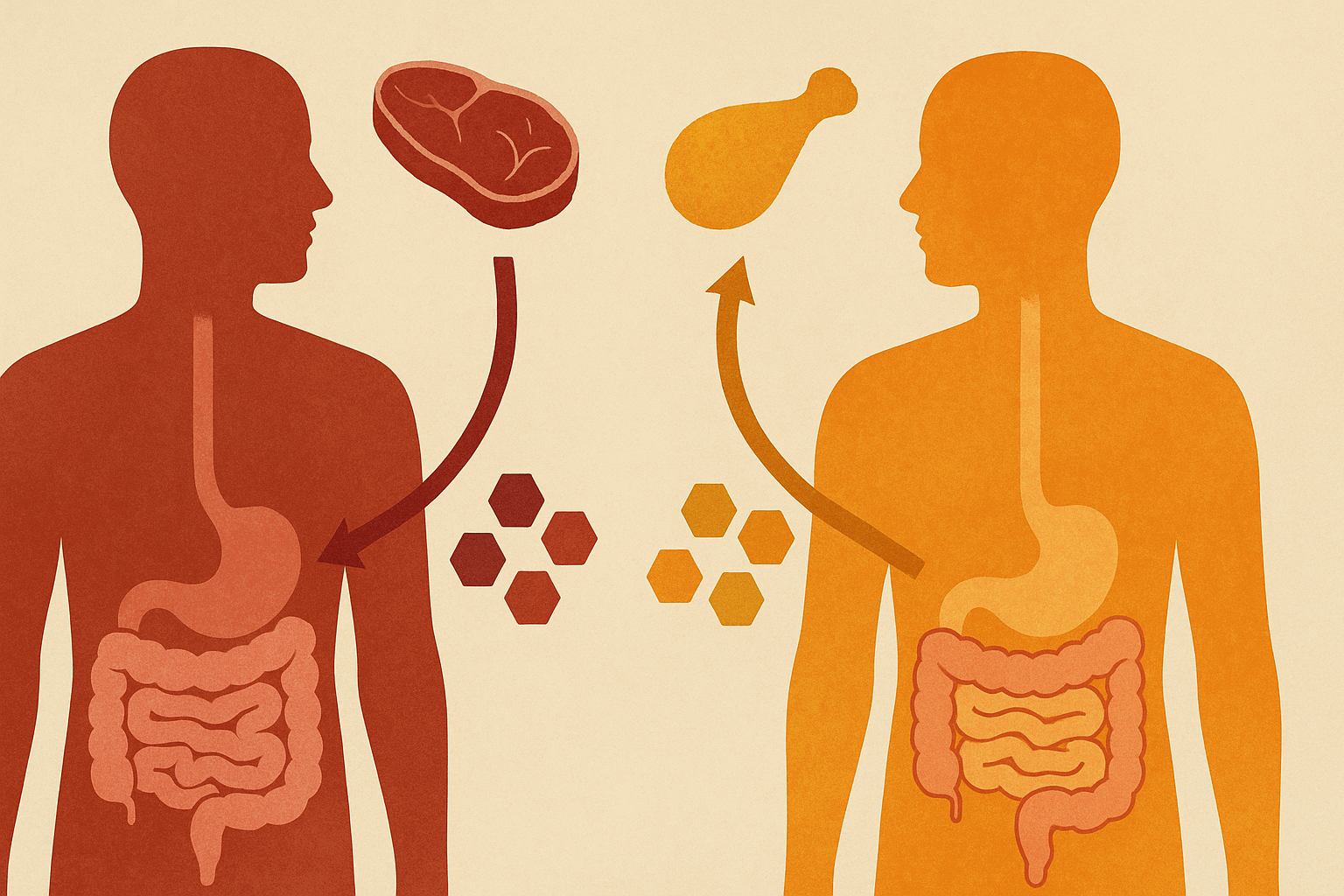
Comparing Digestibility and Amino Acid Absorption
Another important factor when evaluating what has more protein chicken or beef is how the body processes and absorbs the nutrients. The Digestible Indispensable Amino Acid Score (DIAAS) is a modern method used to assess protein quality based on amino acid absorption in the digestive tract. Both beef and chicken score high on the DIAAS scale, indicating excellent protein quality, though beef often scores marginally higher due to its slightly more favorable amino acid profile.
One standout difference lies in the concentration of leucine, an essential amino acid involved in muscle protein synthesis. Beef generally contains slightly more leucine than chicken, which may provide an edge for athletes aiming for hypertrophy. Nevertheless, the difference is not so significant that chicken becomes less effective in supporting muscle repair and growth. For individuals with sensitive digestion or gastrointestinal concerns, chicken may be the gentler option due to its lower fat content and simpler structure.
Digestibility also ties into satiety. Studies show that higher-fat proteins like beef can induce longer-lasting feelings of fullness compared to lean proteins like chicken. This satiety effect could be a strategic advantage in diets aimed at weight management, where reducing overall calorie intake without hunger is a primary goal.
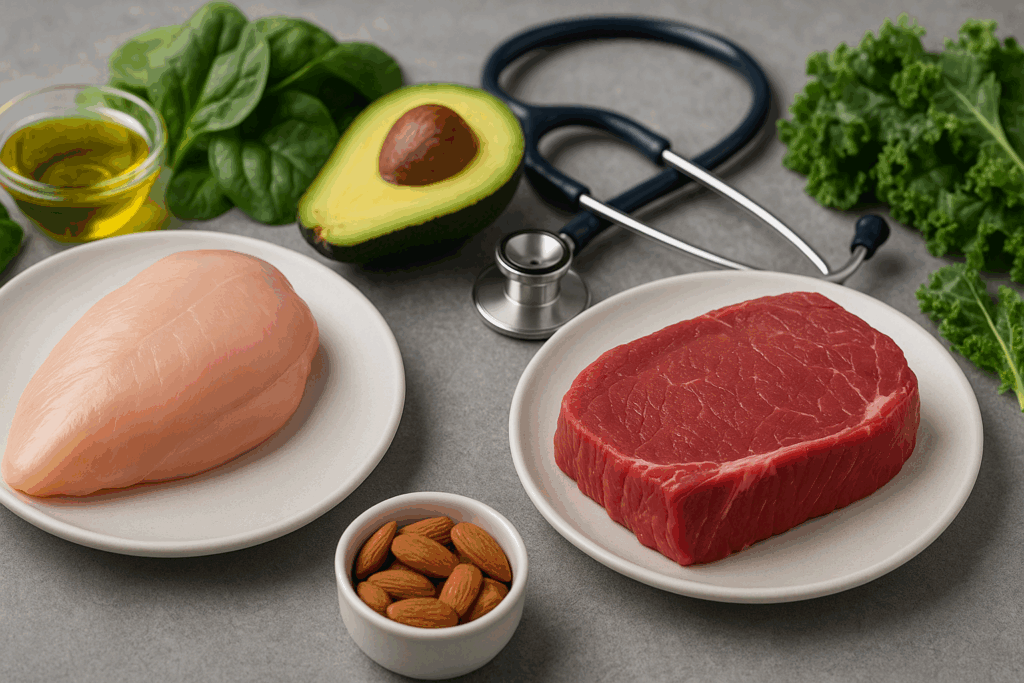
Beef vs Chicken Protein: Cardiovascular and Metabolic Health Implications
When considering is chicken healthier than beef, particularly from a heart health perspective, the comparison hinges largely on fat composition. Chicken, especially white meat without skin, is notably lower in saturated fat than most cuts of beef. Saturated fat, when consumed in excess, has been linked to elevated LDL cholesterol levels, a known risk factor for cardiovascular disease. Consequently, individuals with a family history of heart conditions may prefer chicken as a safer staple.
However, it would be reductive to demonize beef entirely. Grass-fed or lean cuts of beef offer heart-healthy omega-3 fatty acids and conjugated linoleic acid (CLA), which have shown potential benefits in reducing body fat and improving lipid profiles. Moreover, moderate beef consumption has not been consistently linked to heart disease in individuals with balanced diets rich in fruits, vegetables, and whole grains.
From a metabolic standpoint, both proteins support weight loss and maintenance through their thermogenic effect. Digesting protein requires more energy than carbohydrates or fat, which can slightly boost metabolic rate. Protein-rich meals also help regulate blood sugar levels by slowing the absorption of glucose, reducing post-meal spikes and supporting insulin sensitivity.
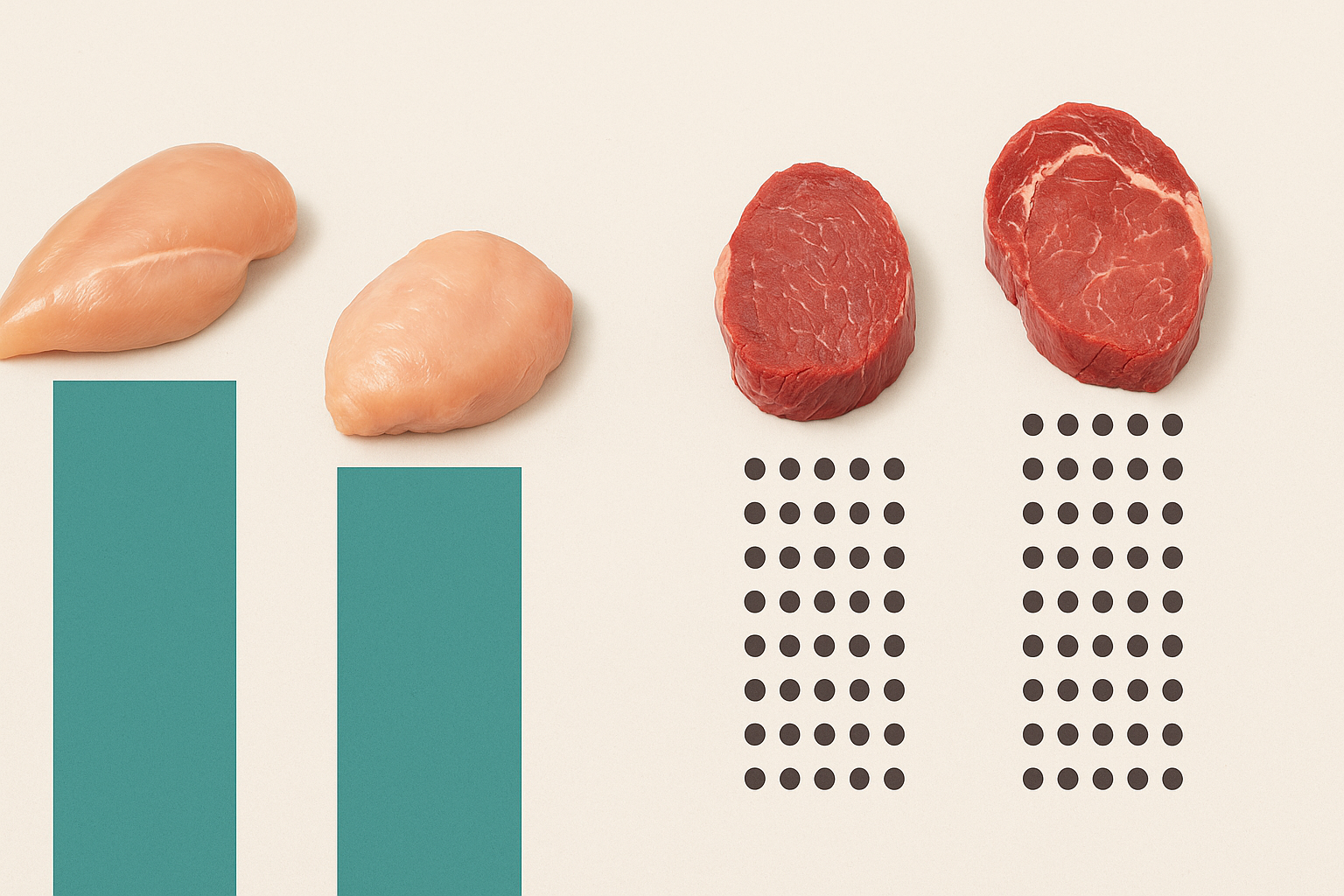
Does Chicken or Steak Have More Protein? Quantity vs Quality
The question does chicken or steak have more protein often depends on the specific cut and preparation method. For example, grilled chicken breast typically offers more protein per ounce than a ribeye steak due to the latter’s higher fat content. However, lean cuts of steak such as sirloin or tenderloin come close to matching chicken in protein content while also providing additional nutrients that may be lacking in a chicken-centric diet.
The quality of protein is equally vital. While both are complete proteins, beef provides a richer array of bioavailable micronutrients. Vitamin B12, abundant in red meat, is essential for nerve function and red blood cell formation—deficiencies of which can lead to fatigue, neurological issues, and cognitive decline. Similarly, iron from beef is in the heme form, which the body absorbs more efficiently compared to the non-heme iron found in plant foods and poultry.
For vegetarians or individuals who limit red meat intake, chicken provides a reliable, high-quality protein source that pairs well with plant-based foods to create a balanced amino acid profile. For omnivores seeking maximum nutritional density, incorporating lean beef in moderation can offer both protein and essential vitamins that support long-term vitality.
Practical Considerations in Choosing Beef vs Chicken Protein
Practicality often plays a major role in dietary decisions, and the debate of beef vs chicken protein extends into affordability, accessibility, and culinary versatility. Chicken, particularly breast or thigh cuts, is typically less expensive than beef, making it more accessible for those on a budget. Its mild flavor and quick cooking time also make it a convenient choice for meal prep and diverse culinary applications.
Beef, on the other hand, is often reserved for special meals or occasions due to its richer flavor and higher cost. However, ground beef, especially lean varieties, offers a cost-effective way to enjoy the nutritional benefits of red meat. It can be used in a wide array of dishes, from meatballs and tacos to stir-fries and casseroles, providing culinary diversity and satisfaction.
Storage and shelf life are additional factors. Chicken, especially when bought fresh, has a shorter shelf life compared to vacuum-sealed or frozen beef. This can influence how frequently it needs to be purchased and prepared, which may affect long-term dietary adherence for busy individuals.
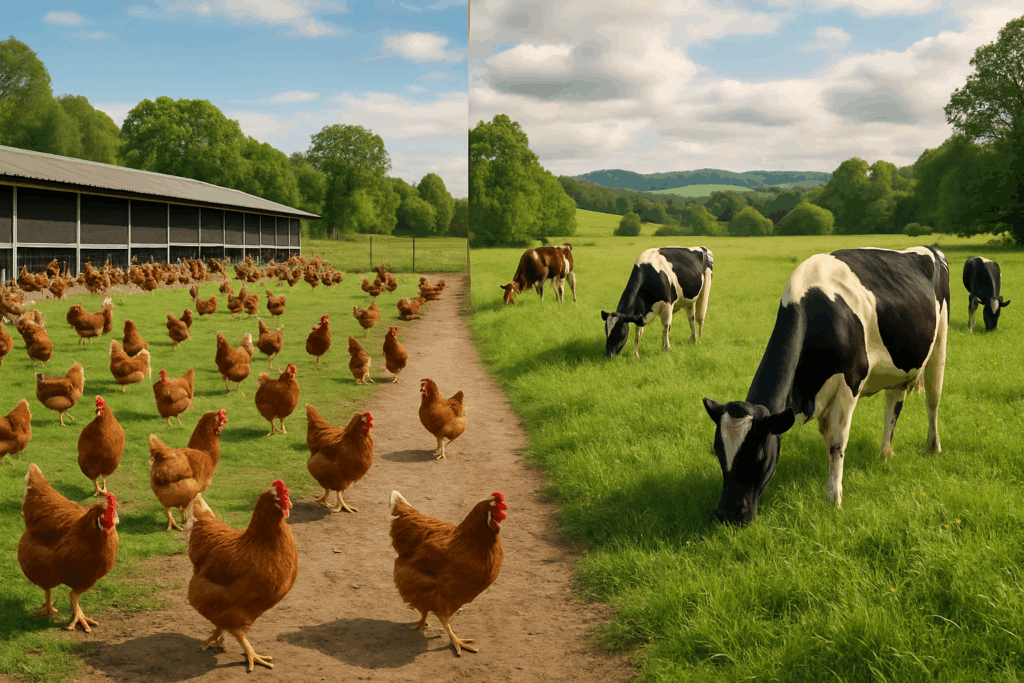
Environmental and Ethical Implications of Protein Choices
Beyond individual health, the decision between chicken and beef has broader environmental and ethical considerations. Beef production is resource-intensive, requiring significantly more land, water, and feed compared to poultry. It also generates higher greenhouse gas emissions, contributing to climate change. From a sustainability standpoint, chicken is generally the more environmentally friendly option.
Ethical concerns around animal welfare also play into consumer choices. While both industries face scrutiny regarding animal treatment, poultry farming often involves confined spaces and rapid growth cycles, which raise distinct ethical questions. Grass-fed beef farms that prioritize animal welfare and sustainable practices may offer a more conscientious alternative, though typically at a higher price point.
These factors are increasingly influencing consumer behavior, especially among environmentally conscious individuals. As such, the choice between beef vs chicken protein may not only reflect nutritional goals but also personal values regarding sustainability and ethical food sourcing.
Food Sensitivities, Allergens, and Digestive Health
Although beef and chicken are generally hypoallergenic compared to shellfish or dairy, food sensitivities can still influence protein choices. Some individuals report intolerance to red meat, which may be due to a condition called alpha-gal syndrome. This rare allergy is triggered by a carbohydrate found in mammalian meat and transmitted through tick bites.
Conversely, certain people experience digestive discomfort from chicken, especially when it’s heavily processed or contains added phosphates. These additives can impair kidney function over time in vulnerable populations. Chicken skin and dark meat may also be harder to digest for individuals with gallbladder or pancreatic issues.
In such cases, protein rotation or the inclusion of enzymatic support supplements can help mitigate digestive challenges. Bone broths, which can be made from either chicken or beef, offer easily digestible collagen, gelatin, and minerals that support gut lining integrity.
Fermented meat products such as bresaola (beef) or chicken sausage with probiotics can also enhance digestibility and nutrient absorption. These products, when consumed in moderation and from reputable sources, diversify protein intake and improve gastrointestinal resilience.

The Role of Protein in Aging and Longevity
Protein needs evolve with age, and the debate over beef vs chicken protein gains new dimensions in the context of healthy aging. Older adults face an increased risk of sarcopenia—the age-related loss of muscle mass—which can lead to frailty, falls, and decreased quality of life.
High-quality, bioavailable protein is essential for preserving lean tissue in older populations. Both beef and chicken are suitable options, but beef’s superior levels of creatine, iron, and zinc may offer added protection against age-related decline in energy, immunity, and muscle repair. Additionally, vitamin B12 absorption decreases with age, making beef a valuable dietary source for elderly individuals.
Chicken, with its lower fat content and milder taste, may be easier to prepare and digest for older adults with chewing or swallowing difficulties. Including both proteins in a soft, well-cooked form such as stews or soups can optimize nutrient intake while reducing preparation challenges.
Timing and distribution of protein intake are also critical. Research suggests that evenly distributing 25 to 30 grams of high-quality protein across meals supports muscle maintenance better than consuming most of it at dinner. Thus, a chicken omelet at breakfast and a beef stir-fry for lunch can offer functional synergy.
Protein Synthesis, Hormonal Balance, and Gender Differences
Another emerging area of research in the beef vs chicken protein comparison involves sex-specific responses to dietary protein. Men and women metabolize amino acids differently due to variations in muscle mass, hormonal balance, and insulin sensitivity. Some studies suggest that women may benefit more from the iron and B12 in beef, particularly during menstruating years when these nutrients are often depleted.
Testosterone, growth hormone, and insulin-like growth factor 1 (IGF-1) are all modulated by dietary protein. Certain compounds in beef, such as creatine and carnosine, have shown a more pronounced anabolic effect in resistance-trained individuals, especially males. However, chicken’s lean protein profile may better suit women aiming for lean muscle tone without excessive caloric intake. Hormonal responses are also tied to how much saturated fat is consumed, which can vary widely between beef and chicken dishes.
Understanding these gender-specific responses to protein can aid in tailoring meal plans. For example, a female athlete may benefit from alternating beef and chicken to optimize micronutrient intake while maintaining lean muscle mass, whereas a male bodybuilder might prioritize lean cuts of beef for its performance-enhancing compounds.

Cultural Relevance and Global Dietary Patterns
Cultural and regional dietary patterns heavily influence the consumption of beef vs chicken protein. In Western nations like the United States and Australia, beef holds cultural significance as a symbol of strength and prosperity. Meanwhile, in East Asian countries like China and Japan, chicken is more commonly consumed due to cost, religious considerations, and cooking traditions.
The Mediterranean diet, often cited for its heart-protective qualities, incorporates lean poultry more frequently than red meat. Conversely, Argentine cuisine places a premium on grass-fed beef, often grilled over open flames to preserve flavor and nutrients. Understanding these patterns helps illuminate how protein choices are embedded in social and environmental contexts.
Religious beliefs also play a role. For instance, certain Hindu sects avoid beef entirely, while kosher dietary laws among Jewish populations prohibit mixing meat and dairy, influencing how beef is consumed. In predominantly Muslim countries, halal practices govern both beef and chicken preparation, with an emphasis on ethical slaughter.
These cultural differences don’t just reflect tradition—they shape nutritional outcomes by affecting how frequently and in what form these proteins are consumed.
What Has More Protein Chicken or Beef: Real-Life Scenarios and Meal Planning
In practical terms, determining what has more protein chicken or beef depends on context. For example, a grilled chicken breast used in a salad may deliver 30 grams of protein with minimal fat, ideal for a post-workout meal. Conversely, a lean steak paired with roasted vegetables and whole grains may provide a balanced dinner rich in protein, iron, and flavor.
Meal planning also offers opportunities for strategic protein variety. Alternating between chicken and beef throughout the week allows individuals to benefit from the distinct nutrients each offers while preventing dietary monotony. For those tracking macros or managing health conditions such as anemia or high cholesterol, rotating between the two can help fine-tune nutrient intake without compromising flavor or satiety.
Cooking methods are equally important. Grilling, baking, and broiling help retain protein content while minimizing added fats. Avoiding deep frying or excessive sauces can keep meals health-focused. Marinades with herbs, lemon, and spices can enhance flavor without sacrificing nutrition, making both chicken and beef enjoyable staples in a well-rounded diet.
Environmental Impact and Regenerative Agriculture
Sustainability has become a key consideration in dietary decisions, and the comparison of beef vs chicken protein now extends into agricultural ethics and carbon footprint assessments. While conventional wisdom holds that chicken is more sustainable due to its lower greenhouse gas emissions, newer frameworks such as regenerative agriculture are redefining the environmental narrative.
Grass-fed beef operations that employ rotational grazing can actually sequester carbon in soil, offsetting emissions and enhancing soil biodiversity. Such methods also reduce water runoff and pesticide use. In contrast, industrial poultry farming often relies on monoculture feed crops, antibiotic use, and confined animal feeding operations (CAFOs), which pose their own environmental and ethical concerns.
It’s also important to consider the entire lifecycle of food production, including feed conversion efficiency, water use, and land degradation. Chickens require less feed per pound of meat, but the quality of life and ecological footprint per bird can be substantial depending on the farming system.
Thus, sustainability isn’t simply about choosing chicken over beef but about supporting regenerative, ethical, and local food systems that prioritize both human and planetary health.
Biochemical Complexity: Protein Subtypes and Functional Peptides
While most people are familiar with protein as a macronutrient necessary for muscle repair, fewer understand that the body recognizes specific peptides—short chains of amino acids—as biological messengers. Emerging research into bioactive peptides reveals that proteins in both beef and chicken are more than just sources of amino acids; they carry health-modulating properties.
Beef peptides, for example, have been shown to exert antihypertensive, antioxidant, and immunomodulatory effects. These peptides can support cardiovascular health beyond traditional macronutrient metrics. Chicken-derived peptides, meanwhile, have demonstrated anti-inflammatory effects in certain animal studies, particularly those found in chicken collagen and skin. These may influence joint health, immune response, and even skin elasticity.
Moreover, heat and enzymatic digestion impact peptide availability. Slow-cooked beef or pressure-cooked chicken may yield different health outcomes compared to grilled or pan-seared counterparts. This illustrates that food preparation methods not only affect taste and texture but also the bioavailability of health-promoting compounds.
Beef vs Chicken Protein: Navigating Trends and Misconceptions
Public perception of beef vs chicken protein has been shaped by cultural trends, media narratives, and evolving health guidelines. For years, red meat was vilified due to its saturated fat content, while chicken was promoted as the leaner, safer choice. However, recent research highlights that lean beef, when consumed in moderation, does not inherently raise disease risk and may even support health when included in a nutrient-rich diet.
Social media and fitness influencers often portray chicken as the quintessential “fit food,” promoting boiled chicken breasts as a dietary staple. While effective for muscle-building, such monotony may lead to nutrient gaps and meal fatigue. Incorporating beef and other protein sources like fish, eggs, and legumes can foster a more balanced and enjoyable eating experience.
It’s also worth noting that not all chicken or beef is created equal. Hormone use, antibiotic exposure, and feed quality vary by source and influence the overall nutrient profile and safety of the meat. Choosing organic, grass-fed, or pasture-raised options can enhance both nutritional value and consumer peace of mind, though availability and cost remain challenges.
Integrating Plant-Based Proteins for Synergistic Effects
While this discussion centers on animal proteins, integrating plant-based sources offers a broader nutritional spectrum. Pairing legumes, nuts, or seeds with beef or chicken creates meals rich in fiber, antioxidants, and phytonutrients.
For instance, a beef chili with black beans delivers a powerful combination of heme iron and fiber, supporting digestion and energy metabolism. A chicken salad with quinoa and avocado offers complete protein, healthy fats, and magnesium. These pairings not only enhance taste and texture but also provide balanced macronutrients and reduced glycemic load.
Furthermore, plant-based proteins may offset some of the environmental and ethical concerns associated with animal agriculture. By adopting a flexitarian approach that includes high-quality beef and chicken alongside legumes, grains, and nuts, individuals can enjoy diverse flavors, meet protein goals, and reduce their carbon footprint.
Frequently Asked Questions (FAQ) on Beef vs Chicken Protein: Lesser-Known Facts, Insights, and Applications
1. How does the bioavailability of beef vs chicken protein affect muscle synthesis?
When comparing beef vs chicken protein, bioavailability—how efficiently your body absorbs and uses the protein—plays a crucial role in muscle synthesis. Beef contains all essential amino acids and is particularly rich in leucine, an amino acid essential for triggering muscle protein synthesis. However, chicken’s leaner composition may digest faster, making it advantageous post-workout when quick amino acid delivery is needed. Additionally, recent research shows that red meat like beef might support long-term muscle retention more effectively in aging adults. Still, athletes often rotate both sources to optimize absorption timing and amino acid profiles for muscle gain and recovery.
2. Beef vs Chicken Protein: Which Is Better for Long-Term Metabolic Health?
While beef vs chicken protein often gets framed in terms of macros, long-term metabolic effects reveal deeper distinctions. Studies suggest that grass-fed beef contains higher levels of omega-3 fatty acids and conjugated linoleic acid (CLA), both associated with improved insulin sensitivity and fat metabolism. Chicken, especially breast meat, is virtually fat-free and lower in cholesterol, which may benefit individuals managing metabolic syndrome. However, overconsumption of processed red meats, even lean beef, has been linked to inflammation markers. A rotation strategy—balancing lean chicken with occasional grass-fed beef—may offer metabolic advantages without adverse effects.
3. Does the iron content in beef make it nutritionally superior to chicken?
Beef significantly outpaces chicken in heme iron content, the type of iron most readily absorbed by the body. This makes it especially beneficial for individuals with iron-deficiency anemia, menstruating women, and endurance athletes. Chicken contains some iron but mostly non-heme, which is less efficiently utilized unless paired with vitamin C-rich foods. However, excess heme iron may increase oxidative stress if consumed in large amounts over time. Thus, while beef is an iron powerhouse, alternating it with chicken and plant-based sources creates a more balanced approach to long-term iron intake.
4. How do cooking methods impact protein quality in chicken versus beef?
Protein denaturation during cooking can influence how digestible and effective the protein is. High-heat methods like grilling or frying can create advanced glycation end products (AGEs), which may reduce protein quality and increase inflammation. With beef, prolonged high-heat cooking may also degrade sensitive nutrients like B vitamins. Chicken, due to its lower fat content, tends to dry out faster and may lose more moisture-bound amino acids when overcooked. Steaming, slow-cooking, or sous-vide methods preserve both chicken and beef protein integrity better, helping retain amino acid availability while reducing carcinogenic compound formation.
5. What Has More Protein, Chicken or Beef, in Real-World Meal Planning?
When evaluating what has more protein, chicken or beef, it’s important to account for serving size, preparation, and fat content. Per cooked ounce, lean beef and chicken breast both offer approximately 7–9 grams of protein. However, chicken breast generally contains less fat, allowing for slightly larger portions without exceeding calorie limits. For instance, a 6-ounce serving of chicken may deliver around 50–55 grams of protein with fewer than 300 calories, whereas the same portion of lean steak may approach 400 calories. In meal prepping scenarios, chicken’s volume efficiency often wins for high-protein, low-calorie meal plans, especially for cutting phases in bodybuilding.
6. Does beef or chicken have more protein when considering organ meats?
Organ meats shift the typical narrative of “does beef or chicken have more protein?” considerably. Chicken liver, for example, is high in protein and packed with micronutrients like folate, vitamin A, and choline, often outperforming beef liver in nutrient density per calorie. However, beef heart and beef tongue provide more protein and taurine, a critical amino acid for cardiac and neurological function. Those seeking functional nutrition often incorporate organ meats from both sources for a broader nutrient spectrum. This approach adds variety and maximizes the bioavailability of overlooked micronutrients in traditional protein calculations.
7. Is chicken healthier than beef for individuals with heart disease risk?
When evaluating whether is chicken healthier than beef for heart health, several nuances emerge. Chicken, particularly skinless breast, contains minimal saturated fat and cholesterol, aligning with heart-healthy dietary guidelines. In contrast, regular consumption of fattier beef cuts—especially those not grass-fed—can elevate LDL cholesterol levels. However, grass-fed or lean cuts of beef do offer cardioprotective nutrients like CLA and B12. The key lies in moderation and sourcing: organic, lean cuts of both meats reduce cardiovascular risk, while processed versions (e.g., deli meats, cured products) from either source elevate it. Thus, health-conscious choices matter more than the meat type alone.
8. What has more protein, chicken or steak, across different cuts and types?
The question “what has more protein, chicken or steak?” depends heavily on cut and preparation. Chicken breast (skinless) consistently ranks among the highest-protein meats, offering around 31 grams per 100 grams. Steak, depending on the cut, ranges from 25 to 29 grams per 100 grams, with tenderloin and sirloin being the leaner, higher-protein options. However, marbled cuts like ribeye or T-bone contain more fat, reducing protein density per calorie. Additionally, portion control can shift outcomes—one person’s 8-ounce steak may deliver more protein than another’s 5-ounce chicken serving. Accurate comparisons require both volume and fat content to be considered.
9. Does chicken or steak have more protein when part of composite meals?
The debate over “does chicken or steak have more protein?” often changes when they’re consumed as part of composite meals. For example, a chicken Caesar salad may include less total meat but more protein from cheese and dressing additives, while a steak taco’s protein load depends heavily on tortilla and toppings. Even marination plays a role—wet marinades can dilute protein content per serving. Thus, in real-life eating scenarios, total meal construction—not just meat choice—determines protein load. Tracking apps and food scales offer the best tools for assessing actual protein content in complex dishes involving chicken or steak.
10. Can cycling between beef and chicken enhance protein diversity and nutritional synergy?
Yes, alternating beef and chicken can enhance both protein diversity and nutrient absorption. Chicken’s lean profile makes it ideal for daily consumption, while beef contributes unique nutrients like zinc, creatine, and B12 that support cognitive and muscular health. This alternating strategy allows for balanced exposure to different amino acid ratios and micronutrient arrays. Emerging research also supports the notion of “protein rotation” for microbiome diversity, which may indirectly improve digestion and immunity. Ultimately, beef vs chicken protein should be seen not as a binary choice but as complementary elements in a broader, nutrient-rich dietary plan.
Conclusion: Making Informed Choices with Beef vs Chicken Protein
Ultimately, the question of which is superior in the beef vs chicken protein debate does not yield a one-size-fits-all answer. Both protein sources offer unique advantages that can support a high-protein diet, depending on individual goals, dietary restrictions, and ethical preferences. Chicken excels in its low fat content, affordability, and gentle digestibility, making it ideal for those pursuing weight loss or managing cholesterol. Beef, particularly lean cuts, stands out for its dense micronutrient profile, satiety effects, and muscle-building potential.
To maximize benefits, a diversified approach that includes both beef and chicken—along with plant-based proteins—is often the most sustainable and nutritionally balanced path. By understanding the nuanced differences between does beef or chicken have more protein, individuals can tailor their diets with precision and confidence. Whether the goal is athletic performance, metabolic health, or ethical eating, informed protein choices pave the way for long-term vitality and well-being.
Incorporating beef vs chicken protein into a high-protein diet requires more than simply comparing numbers; it demands a holistic perspective that weighs nutrition, digestibility, ethics, environmental impact, and personal preferences. By staying informed and choosing quality sources, you can build a diet that not only supports your body but also aligns with your values and lifestyle for years to come.
Further Reading:
Beef vs chicken: Nutritional differences


